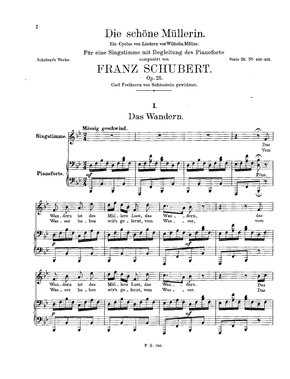Strophic form

Strophic form– also calledverse-repeating form,chorusform,AAA song form,orone-part song form– is a song structure in which all verses or stanzas of the text are sung to the same music.[1]Contrasting song forms includethrough-composed,with new music written for every stanza,[1]andternary form,with a contrasting central section.
The term is derived from the Greek wordστροφή,strophē,meaning "turn". It is the simplest and most durable ofmusical forms,extending a piece ofmusicby repetition of a single formalsection.This may be analyzed as "A A A...". This additive method is the musical analogue of repeated stanzas in poetry or lyrics and, in fact, where the text repeats the same rhyme scheme from onestanzato the next, thesong's structurealso often uses either the same or very similar material from one stanza to the next.
Amodifiedstrophic form varies the pattern in some stanzas (A A' A "...) somewhat like a rudimentarytheme and variations.Contrasting verse-chorus formis abinary formthat alternates between two sections of music (ABAB), although this may also be interpreted as constituting a larger strophic verse-refrainform. While the terms 'refrain' and 'chorus' are often used interchangeably, 'refrain' may indicate a recurring line of identical melody and lyrics as a part of the verse (as in "Blowin' in the Wind":"...the answer my friend... "), while 'chorus' means an independent form section (as in"Yellow Submarine":"We all live in... ").[2]
Manyfolkandpopularsongs are strophic in form, including thetwelve-bar blues,ballads,hymnsand chants. Examples include "Barbara Allen","Erie Canal","Michael, Row the Boat Ashore",[3]and "Oh! Susanna"(A = verse & chorus).[4]Traditional and modern Country songs like "This land is your land"is also a strophic form.
Manyclassicalart songsare also composed in strophic form, from the 17th century Frenchair de courto 19th century Germanliederand beyond.Haydnused the strophic variation form in many of his string quartets and a few of his symphonies, employed almost always in the slow second movement.Franz Schubertcomposed many important strophic lieder, including settings of both narrative poems and simpler, folk-like texts, such as his "Heidenröslein"and" Der Fischer ".[1]Several of the songs in hissong cycleDie schöne Müllerinuse strophic form.
See also
[edit]- Antistrophein thelyricalperformances of theGreek chorus
References
[edit]- ^abcTilmouth, Michael(2001). "Strophic".Grove Music Online.doi:10.1093/gmo/9781561592630.article.26981.
- ^cf. von Appen/Frei-Hauenschild 2015.
- ^Duckworth, William(2012).A Creative Approach to Music Fundamentals,p. 319.ISBN9780840029997.
- ^Pen, Ronald (1991).Schaum's Outline of Introduction to Music,p. 96.ISBN9780070380684.
Sources
[edit]- Appen, Ralf von / Frei-Hauenschild, Markus"AABA, Refrain, Chorus, Bridge, Prechorus – Song Forms and their Historical Development".In:Samples. Online Publikationen der Gesellschaft für Popularmusikforschung/German Society for Popular Music Studies e.V.Ed. by Ralf von Appen,André DoehringandThomas Phleps.Vol. 13 (2015).
